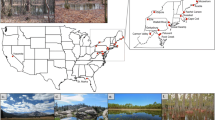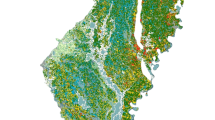Abstract
Climate change is expected to lead to greater temporal climatic variability across broad spatial extents. A potential consequence is that shifts in climatic conditions might alter how local habitat affects the population growth of animals dependent on those habitats for at least part of their life cycle. We tested whether such a phenomenon occurred when the North American Prairie Pothole Region transitioned through periods of wet and dry conditions by modeling the population growth of seven duck species over 52 years (1961–2012). We found that the influence of local habitat quality—indexed by wetland availability—on duck population growth varied in magnitude and direction on an annual basis. While the effect of wetlands was relatively small in most years, there were some years in which wetlands strongly affected duck population growth in both positive and negative directions (e.g., negative in 2002 and positive in 2008). Contrary to our expectation, inter-annual variability in the effect of wetlands on duck population growth did not depend on regional precipitation. We also found that for two species—American Wigeon (Anas americana) and Green-winged Teal (A. carolinensis)—duck population growth in the presence of wetlands rarely differed from what would be expected solely under density dependence. Our study is the first to demonstrate that the effect of local habitat on population growth varies over time even if the cause of that variation remains unexplained. Consequently, any study that attempts to identify a species’ critical habitat using time series abundance data must consider that local relationships are non-stationary. More complicated measures of climate change may reveal how local drivers of population growth depend on broader temporal climatic patterns.



Similar content being viewed by others
References
Bahn V, McGill BJ (2007) Can niche-based distribution models outperform spatial interpolation? Glob Ecol Biogeogr 16:733–742
Beguin J, Martino S, Rue H, Cumming SG (2012) Hierarchical analysis of spatially autocorrelated ecological data using integrated nested Laplace approximation. Methods Ecol Evol 3:921–929
Bivand R, Gómez-Rubio V, Rue H (2015) Spatial data analysis with R-INLA with some extensions. J Stat Softw 63:1–31
Blangiardo M, Cameletti M (2015) Spatial and spatio-temporal Bayesian models with R-INLA. Wiley, Chichester
Brown CR, Brown MB (2014) Breeding time in a migratory songbird is predicted by drought severity and group size. Ecology 95:2736–2744
Clark JS, Bjørnstad ON (2004) Population time series: process variability, observation errors, missing values, lags, and hidden states. Ecology 85:3140–3150
Cudworth NL, Koprowski JL (2013) Foraging and reproductive behavior of Arizona gray squirrels (Sciurus arizonensis): impacts of climatic variation. J Mammal 94:683–690
Dennis B, Ponciano JM, Taper ML (2010) Replicated sampling increases efficiency in monitoring biological populations. Ecology 91:610–620
Drever MC, Wins-Purdy A, Nudds TD, Clark RG (2004) Decline of duck nest success revisited: relationships with predators and wetlands in dynamic prairie environments. Auk 121:497–508
Feldman RE, Anderson MG, Howerter DW, Murray DL (2015) Where does environmental stochasticity most influence population dynamics? An assessment along a regional core-periphery gradient for prairie breeding ducks. Glob Ecol Biogeogr 24:896–904
Fowler NL, Pease CM (2010) Temporal variation in the carrying capacity of a perennial grass population. Am Nat 175:504–512
Greenwood RJ, Sargeant AB, Johnson DH, Cowardin LM, Shaffer TL (1995) Factors associated with duck nest success in the Prairie Pothole Region of Canada. Wildl Monogr 128:3–57
Jamieson LE, Brooks SP (2004) Density dependence in North American ducks. Anim Biodivers Conserv 27:113–128
Johnson DH, Grier JW (1988) Determinants of breeding distributions of ducks. Wildl Monogr 100:3–37
Johnson WC, Millett BV, Gilmanov T, Voldseth RA, Guntenspergen GR, Naugle DE (2005) Vulnerability of northern prairie wetlands to climate change. Bioscience 55:863–872
Krapu GL, Klett A, Jorde D (1983) The effect of variable spring water conditions on mallard reproduction. Auk 100:689–698
Lande R (1993) Risks of population extinction from demographic and environmental stochasticity and random catastrophes. Am Nat 142:911–927
Lebreton J-D, Gimenez O (2013) Detecting and estimating density dependence in wildlife populations. J Wildl Manage 77:12–23
Levin SA (1992) The problem of pattern and scale in ecology. Ecology 73:1943–1967
Lillegård M, Engen S, Sæther B-E, Grøtan V, Drever MC (2008) Estimation of population parameters from aerial counts of North American mallards: a cautionary tale. Ecol Appl 18:197–207
Lindgren F, Rue H (2015) Bayesian spatial modelling with R-INLA. J Stat Softw 63:1–25
Maron JL, Baer KC, Angert AL (2014) Disentangling the drivers of context-dependent plant-animal interactions. J Ecol 102:1485–1496
McIntire EJB, Fajardo A (2009) Beyond description: the active and effective way to infer processes from spatial patterns. Ecology 90:46–56
Millett BV, Johnson WC, Guntenspergen GR (2009) Climate trends of the North American prairie pothole region 1906–2000. Clim Change 93:243–267
Mitchell TD, Jones PD (2005) An improved method of constructing a database of monthly climate observations and associated high-resolution grids. Int J Climatol 25:693–712
Murkin HR, Ross L (2000) Invertebrates in prairie wetlands. In: Murkin HR, van der Valk A, Clark W (eds) Prairie wetland ecology: the contribution of the Marsh Ecology Research Program. Iowa State University Press, Ames, pp 201–248
Murray DL, Anderson MG, Steury TD (2010) Temporal shift in density dependence among North American breeding duck populations. Ecology 91:571–581
Phillips ML, Clark WR, Sovada MA, Horn DJ, Koford RR, Greenwood RJ (2003) Predator selection of prairie landscape features and its relation to duck nest success. J Wildl Manage 67:104–114
Purves DW (2009) The demography of range boundaries versus range cores in eastern US tree species. Proc Biol Sci 276:1477–1484
R Development Core Team (2016) R: a language and environment for statistical computing. R Foundation for Statistical Computing, Vienna, Austria. http://www.r-project.org
Ricklefs RE (2013) Habitat-independent spatial structure in populations of some forest birds in eastern North America. J Anim Ecol 82:145–154
Ross BE, Hooten MB, Koons DN (2012) An accessible method for implementing hierarchical models with spatio-temporal abundance data. PLoS One 7:1–8
Ross BE, Hooten MB, Devink J, Koons DN (2015) Combined effects of climate, predation, and density dependence on Scaup population dynamics. Ecol Appl 25:1606–1617
Rue H, Martino S, Chopin N (2009) Approximate Bayesian inference for latent Gaussian models using integrated nested Laplace approximations (with discussion). J R Statistical Soc B 71:319–392
Sæther B-E, Lillegård M, Grøtan V, Drever MC, Engen S, Nudds TD, Podruzny KM (2008) Geographical gradients in the population dynamics of North American prairie ducks. J Anim Ecol 77:869–882
Sauer JR, Hines JE, Fallon KL, Pardieck DJ, Ziolkowski DJ Jr, Link WA (2014) The North American Breeding Bird Survey, Results and Analysis 1966–2012. Version 02.19.2014. USGS Patuxent Wildlife Research Center, Laurel
Smith GW (1995) A critical review of the aerial and ground surveys of breeding waterfowl in North America. Biological Science Report 5, National Biological Service, Washington D.C
Sorenson LG, Goldberg R, Root TL, Anderson MG (1998) Potential effects of global warming on waterfowl populations breeding in the Northern Great Plains. Clim Change 40:343–369
Thomas A, Best N, Lunn D, Arnold R, Spiegelhalter D (2004) GeoBUGS User Manual, v 1.2. http://www.mrc-bsu.cam.ac.uk/bugs. Accessed 30 Sept 2012
van Buuren S, Groothuis-Oudshoorn K (2011) mice: Multivariate Imputation by Chained Equations in R. J Stat Softw 45:1–67
Vickery WL, Nudds TD (1984) Detection of density-dependent effects in annual duck census. Ecology 65:96–104
Viljugrein H, Stenseth NC, Smith GW, Steinbakk GH (2005) Density dependence in North American ducks. Ecology 86:245–254
Walker J, Rotella JJ, Stephens SE, Lindberg MS, Ringelman JK, Hunter C, Smith AJ (2013) Time-lagged variation in pond density and primary productivity affects duck nest survival in the Prairie Pothole Region. Ecol Appl 23:1061–1074
Werner BA, Johnson WC, Guntenspergen GR (2013) Evidence for 20th century climate warming and wetland drying in the North American Prairie Pothole Region. Ecol Evol 3:3471–3482
Williams CK, Ives AR, Applegate RD (2003) Population dynamics across geographical ranges: time-series analyses of three small game species. Ecology 84:2654–2667
Winder M, Schindler DE (2004) Climate change uncouples trophic interactions in an aquatic ecosystem. Ecology 85:2100–2106
Yang LH, Bastow JL, Spence KO, Wright AN (2008) What can we learn from resource pulses? Ecology 89:621–634
Yeager LA, Stoner EW, Zapata MJ, Layman CA (2014) Does landscape context mediate the nature of density dependence for a coral reef fish? Ecol Appl 24:1833–1841
Zimpfer NL, Rhodes WE, Silverman ED, Zimmerman, GS, Richkus KD (2012) Trends in duck breeding populations 1955-2012, Administrative Report. US Fish and Wildlife Service, Division of Migratory Bird Management, Laurel
Acknowledgments
We thank all of those who have diligently surveyed for ducks as part of the North American Waterfowl Breeding Population and Habitat Survey. This research was undertaken, in part, thanks to funding from the Canada Research Chairs program. Additional funding came from the Institute for Wetland and Waterfowl Research through Ducks Unlimited Canada and the Branch of Population and Habitat Assessment, U.S. Fish and Wildlife Service. We appreciate the constructive feedback provided by the handling editor, an anonymous reviewer, and David Koons.
Author information
Authors and Affiliations
Corresponding author
Electronic supplementary material
Below is the link to the electronic supplementary material.
Rights and permissions
About this article
Cite this article
Feldman, R.E., Anderson, M.G., Howerter, D.W. et al. Temporal variability in the way local habitat affects duck population growth. Popul Ecol 58, 525–533 (2016). https://doi.org/10.1007/s10144-016-0560-3
Received:
Accepted:
Published:
Issue Date:
DOI: https://doi.org/10.1007/s10144-016-0560-3




